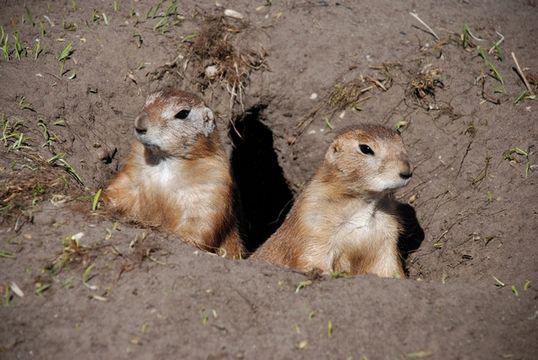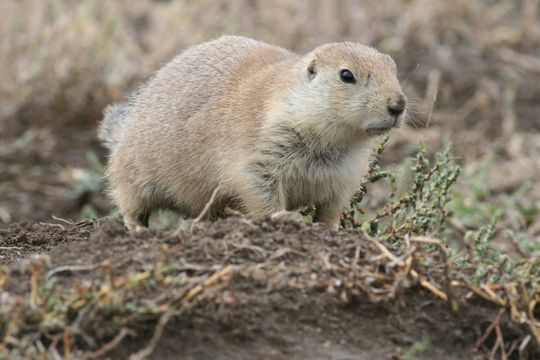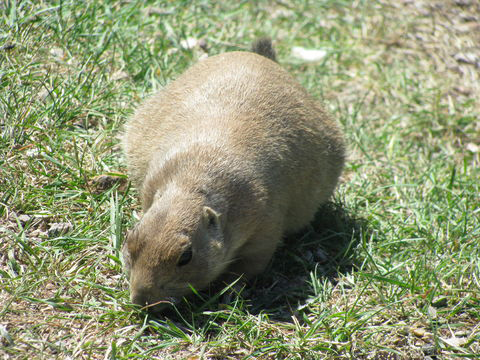Can Prairie Dogs Save Mexico's Prairie From the Desert?
Air Date: Week of August 16, 2013

Prairie Dogs (Encyclopedia of Life)
There were once billions of black-tailed prairie dogs across the prairies of the West and Mexico. Today there is only a fraction of the original population left but activists in Mexico are working to bring back the prairie dogs and help restore the prairie along with them.
Transcript
CURWOOD: It's Living On Earth, I'm Steve Curwood. Life on our planet is incalculably diverse, with organisms that have evolved to fill every available habitat. But ecosystems are interdependent, and if you remove a species, you can upset the whole balance. Today, reporter Ari Daniel Shapiro brings news of one particular animal - and its vital role on Mexico's prairie.
SHAPIRO: Gerardo Ceballos is only 54, but he feels like he’s racing against a clock.
CEBALLOS: I don’t have too many years left.
SHAPIRO: Ceballos is refusing to let his time run out before restoring a special place in his native Mexico.
Our story actually starts well before Ceballos was born – back in the 1800s – when cattle ranching was surging through the prairies of North America, from Manitoba, Canada all the way down to Chihuahua in Mexico. And this is where the real heroes of our story come in – though, at the time they were no heroes to the cattle industry. I’m talking about Cynomys ludovicianus, or black-tailed prairie dogs.
CEBALLOS: Prairie dogs are really nice animals. They are the size of a relatively large cat.
SHAPIRO: They’re a kind of squirrel that can stand on two legs to survey the grasslands for predators. And prairie dogs thrived in North America.
CEBALLOS: Probably 30 billion prairie dogs used to live in those grasslands.
SHAPIRO: But ranchers came to believe that prairie dogs were competing with their cattle for grass, and that cows and horses were breaking their legs by stepping into the prairie dog burrows. Opinions are divided on how serious these problems were. But many ranchers were convinced – and with support from the US government – they launched an all-out war on the prairie dogs. One weapon of choice was a kind of nerve toxin.
CEBALLOS: It’s a poison that will produce convulsions, a failure of the lungs and the heart. It’s a really nasty thing.
SHAPIRO: Tablets of this stuff were tossed down into the burrows, where they produced a toxic vapor that killed everything in its wake.
CEBALLOS: We are talking about probably billions of prairie dogs.
SHAPIRO: Billions that were killed by this toxin?
CEBALLOS: By poisoning and then by the advance of agriculture. It has been one of the most dramatic, drastic exterminations of an animal by humans.
SHAPIRO: Within 50 to 60 years, prairie dogs were eradicated from 98 percent of the area they used to call home; from 30 billion animals to 1 or 2 million.
Without prairie dogs, the prairies transformed. In Mexico, the desert moved in – thanks to a shrub called mesquite. It pushes a deep root into the Earth, sucking up water, and it attracts small animals that devour the grasses ringing the mesquite.
Prairie dogs can’t stand the plant. It blocks their view of the horizon where a predator might be lurking. So they do whatever they can to get rid of it. They chew up the roots. They suck on the stems. They run around like little gardeners, keeping the desert at bay.
So with very few prairie dogs left, the mesquite helped create desert scrubland until there was little grassy prairie remaining. And with the arrival of the desert...

Cynomys ludovicianus Black-tailed PrairieDog (Photo: Arthur Chapman)
CEBALLOS: You lose the ability of this landscape to maintain wildlife and plants. But also the scrubland is not good for cattle.
SHAPIRO: So the land no longer supported the very ranching it was altered for.
Let’s fast forward now to the summer of 1987, when Ceballos was in the middle of his doctorate in Arizona. He and his wife were driving back to Mexico through what used to be the grasslands, in Chihuahua, an area he’d never visited before. It was pretty much all desert. But then one day...
CEBALLOS: We were not prepared mentally to see what we saw.
SHAPIRO: Grasslands waving in the wind. This area had been spared.
CEBALLOS: It was mind-blowing because all the way to the horizon – there were prairie dogs and prairie dogs and prairie dogs. And then the next day we saw badgers. Badgers are very rare in Mexico. Golden eagles are also very rare in Mexico, and we saw more than 20 there in one single day. It hit me immediately the idea that prairie dogs should have some role.
SHAPIRO: Some role in making the prairie possible. In the last 20 years, as an ecologist at the National Autonomous University of Mexico, Ceballos has shown that prairie dogs are a keystone species. That is, everything in the grassland ecosystem depends on them. Their burrows provide shelter for small mammals. Predators – like coyotes and hawks – feed on prairie dogs. These days, Ceballos is resuscitating the prairies, by reintroducing the prairie dogs.
CEBALLOS: Within one year, they destroy most of the mesquite.
SHAPIRO: He’s also reintroducing black-footed ferrets – a species that hasn’t been in Mexico for at least a hundred years, pronghorn antelopes, bighorn sheep, wolves - even bison, which he’s getting from the US. He’s partnered with environmental groups and the government to create a reserve that protects these species, and then offers local people ways to benefit economically from the grassland. And gradually, a portion of the Mexican prairies are coming back.
CEBALLOS: A good scientist has to do good research, but then has to translate it into action. There is no way that we can continue just being like historians – recording all the things that we are losing, instead of becoming actors. Now, my main objective in life is to save as many species of plants and animals as I can.

(Encyclopedia of Life)
SHAPIRO: Which is why – even at 54 – Ceballos feels he doesn’t have a moment to waste. He has a legacy to leave his country. For Living on Earth, I’m Ari Daniel Shapiro.
CURWOOD: Our story on prairie dogs is part of the series, One Species at a Time, produced by Atlantic Public Media, with support from the Encyclopedia of Life. To see some photos, follow the trail to our website loe dot org – or check out our Facebook page – it’s PRI’s Living on Earth.
Links
Living on Earth wants to hear from you!
Living on Earth
62 Calef Highway, Suite 212
Lee, NH 03861
Telephone: 617-287-4121
E-mail: comments@loe.org
Newsletter [Click here]
Donate to Living on Earth!
Living on Earth is an independent media program and relies entirely on contributions from listeners and institutions supporting public service. Please donate now to preserve an independent environmental voice.
NewsletterLiving on Earth offers a weekly delivery of the show's rundown to your mailbox. Sign up for our newsletter today!
 Sailors For The Sea: Be the change you want to sea.
Sailors For The Sea: Be the change you want to sea.
 The Grantham Foundation for the Protection of the Environment: Committed to protecting and improving the health of the global environment.
The Grantham Foundation for the Protection of the Environment: Committed to protecting and improving the health of the global environment.
 Contribute to Living on Earth and receive, as our gift to you, an archival print of one of Mark Seth Lender's extraordinary wildlife photographs. Follow the link to see Mark's current collection of photographs.
Contribute to Living on Earth and receive, as our gift to you, an archival print of one of Mark Seth Lender's extraordinary wildlife photographs. Follow the link to see Mark's current collection of photographs.
 Buy a signed copy of Mark Seth Lender's book Smeagull the Seagull & support Living on Earth
Buy a signed copy of Mark Seth Lender's book Smeagull the Seagull & support Living on Earth

